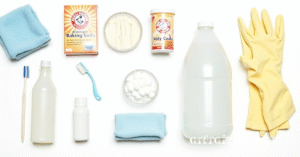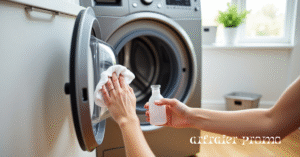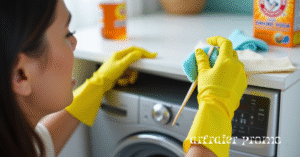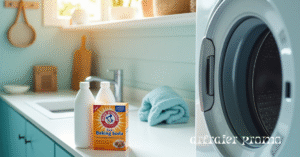Keeping your washing machine clean is essential not only to maintain its performance but also to ensure your clothes come out fresh and odor-free. Over time, dirt, detergent residues, mold, and mildew can build up inside your washing machine, causing unpleasant smells and even damage. This guide will walk you through how to clean your washing machine effectively, step-by-step, and share expert tips for ongoing maintenance.
Why Cleaning Your Washing Machine Matters
Advantages of Regular Cleaning:
-
Better Performance: Removes detergent buildup, helping your machine run efficiently.
-
Fresh Smelling Clothes: Eliminates musty odors caused by mold and mildew.
-
Longer Machine Life: Prevents corrosion and wear caused by residue and mold.
-
Healthier Laundry: Reduces bacteria and allergens in your washing machine.
Disadvantages of Not Cleaning:
-
Clothes may come out smelling bad or dirty despite washing.
-
Mold growth can cause allergic reactions or skin irritation.
-
Machine parts can get damaged, leading to costly repairs.
-
Unpleasant odors can spread to your laundry area.
Tools You’ll Need for Cleaning Your Washing Machine
-
Microfiber cloth or sponge
-
Old toothbrush or small scrub brush
-
White vinegar
-
Baking soda
-
Bleach (use with caution)
-
Bucket
-
Rubber gloves
-
Toothpicks or cotton swabs (for tight spaces)

Safety Tip: Always unplug your washing machine before starting any cleaning process.
Step-by-Step Guide: How to Clean Your Washing Machine
Step 1: Empty and Unplug
Remove all clothes and turn off your machine. Unplug it from the power source to avoid any accidents.
Step 2: Clean the Detergent Dispenser
Take out the detergent drawer and soak it in warm, soapy water. Use a toothbrush to scrub away detergent residue and mildew. Rinse well and dry before placing it back.
Step 3: Clean the Filter
Check your washing machine’s manual for filter location. Remove and clean it of lint, coins, and debris. Rinse under running water and reinstall.
Step 4: Clean the Drum
-
For front-loaders, wipe the rubber door seal with a cloth dipped in a vinegar-water solution to remove mold and dirt.
-
For top-loaders, use a sponge to scrub the drum with a mixture of baking soda and water.

Step 5: Run a Cleaning Cycle
-
Add either bleach or baking soda and vinegar into the drum or detergent dispenser.
-
Run the machine on the hottest and longest cycle to remove buildup and sanitize.
Step 6: Wipe Down Exterior and Door
Use a damp cloth to clean the outside and the door glass or lid. Don’t forget the rubber seal around the door where grime can accumulate.

Step 7: Leave the Door Open
After cleaning, leave the washing machine door open for a few hours to air dry and prevent mold growth.
How to Clean Washing Machine with Bleach
Bleach is a powerful disinfectant that kills mold, bacteria, and mildew effectively. Pour about 1 cup of bleach into the detergent dispenser or directly into the drum, then run a hot water cycle.
Pros:
-
Kills germs and mold quickly
-
Removes tough stains and odors
Cons:
-
Can damage rubber seals if used too frequently
-
Strong fumes require good ventilation
How to Clean Washing Machine with Baking Soda
Baking soda is a natural, gentle cleaner that deodorizes and removes residue. Mix 1/2 cup of baking soda with 1/4 cup of water and add it to the drum. Follow with 2 cups of white vinegar in the detergent dispenser and run a hot cycle.
Pros:
-
Safe and environmentally friendly
-
Neutralizes odors without harsh chemicals
Cons:
-
May not be enough for heavy mold or buildup on its own

How to Clean Washing Machine Top Loader
-
Fill the drum with hot water (highest level).
-
Add 1 quart of white vinegar and let it soak for an hour.
-
Scrub the interior with a soft brush or sponge.
-
Drain the water and run a full cycle with 1 cup of baking soda.
-
Wipe the exterior and agitator.
How to Clean Washing Machine Front Loader
-
Wipe the rubber door seal thoroughly with a vinegar solution.
-
Remove and clean the detergent drawer.
-
Run a hot water cycle with 2 cups white vinegar.
-
Follow with a hot cycle adding 1/2 cup baking soda.
-
Keep the door open after cleaning for ventilation.
How to Clean Washing Machine Whirlpool
Whirlpool machines generally follow the same cleaning principles but always check your user manual for any brand-specific advice. Use gentle, non-abrasive cleaners and avoid excessive bleach. Whirlpool also recommends regular monthly cleaning cycles with their proprietary washing machine cleaner products for best results.
Remove Mold and Odors from Your Washing Machine
Mold grows in moist, dark places such as the rubber door seal or detergent drawer. To remove it:
-
Clean the seals and drawers with a vinegar and water solution or bleach solution.
-
Regularly wipe dry after use.
-
Leave the door open between washes.
Expert Advice and Tips for Maintaining a Clean Washing Machine
-
Clean your machine once a month for best results.
-
Use the right amount of detergent to avoid buildup.
-
Avoid using fabric softeners excessively.
-
Regularly check and clean filters and dispensers.
-
Let the door stay open after washing to dry out the interior.
For a detailed visual guide, check out washing machine cleaning tips from The Spruce.
Conclusion
Regularly cleaning your washing machine is essential for keeping your laundry fresh, your appliance running efficiently, and preventing unpleasant odors or mold buildup. Whether you choose to use bleach, baking soda, or natural cleaning methods, following a simple step-by-step routine will make maintenance easy and effective. Remember to clean all parts—the drum, dispenser, filter, and seals—and adopt good habits like leaving the door open to air dry. With these tips and expert advice, your washing machine will stay in great shape for years to come, ensuring every load of laundry comes out clean and fresh.
Frequently Asked Questions (FAQs)
Q1: How often should I clean my washing machine?
A: Ideally, once a month to prevent mold and residue buildup.
Q2: Can I use bleach every time I clean my washing machine?
A: No, bleach can damage seals over time. Use it sparingly, alternating with gentler methods like baking soda and vinegar.
Q3: Why does my washing machine smell bad?
A: Mold, mildew, detergent buildup, and trapped moisture are common causes.
Q4: Is it safe to clean my washing machine with vinegar?
A: Yes, vinegar is safe and effective for regular cleaning and deodorizing.
Q5: How can I prevent mold from growing in my washing machine?
A: Leave the door open after each wash to allow air circulation and wipe seals dry regularly.






